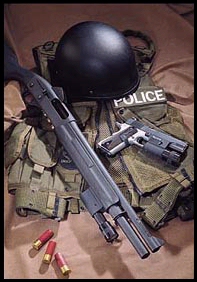
The repeating 12ga. combat shotgun has been a law enforcement weapon for 100 years now, starting with the introduction of the Winchester 1897 pump shotgun. And, while it's reputation as a manstopper is legendary, unfortunately little has changed in the past 100 years. If you consider the pump shotguns currently in use by law enforcement agencies, most are still pump action, bead sighted, cylinder bore, 4-6 shot weapons. Other than the exposed hammer, the Winchester 1897 could be used today and do just as adequately as many of the shotguns we currently have available.
This doesn't mean that there isn't room for improvement. Indeed there is. The way in which we've viewed, and been using, shotguns for the past century has been much like someone who owns a high performance automobile, but never takes it past second gear. The shotgun is capable of doing much more. But, until very recently no one has had the interest or taken the time and effort to see just how far the performance envelope of the shotgun could be pushed.
Most of the credit for bringing the shotgun out of the 19th century and into the 21st century goes to Jeff Cooper and the staff of the Gunsite Training Center, who continue his work. In the 1980's Col. Cooper and his staff took a long hard look at combat shotguns with the goal of improving the weapons themselves and the manner in which they are handled, fired, and employed in gunfights.
They were successful and the result of their efforts is the tactical shotgun concept. Basically this is a more modern and realistic approach to the shotgun as a Close Quarters Battle (CQB) weapon along with a series of modifications which take the shotgun to previously unreachable performance levels. No longer is this weapon considered a mere point and fire "alley sweeper" good only for extremely close confrontations. Nor is 50 yards ever again going to be considered the maximum effective range for slugs with this weapon. With a properly configured tactical shotgun you have the most powerful and effective close range shoulder fired weapon in existence as well as a weapon that is capable of delivering accurate solid projectile fire out to 125+ yards. It's also a weapon capable of employing less lethal specialty impact munitions, barricade penetrating gas rounds, lockbuster rounds, aerial burst distraction devices, flares and any number of unusual lethal force specialty rounds. In short it's extremely effective and versatile.
Fortunately, some of the shotgun manufacturers have started to pay attention and are now making shotguns that are capable of tactical shotgun performance. But an understanding of the specific attributes of the tactical shotgun design is needed in order to make a truly informed choice.
What I intend to do with this presentation is to discuss the attributes of the tactical shotgun, and in doing so, dispel some of the myths and misconceptions of the shotgun that have halted it's development. In the end, hopefully, you'll have a greater understanding and appreciation of the weapon.
There are quite a few shotgun manufacturers out there and nearly all of them produce some type of combat type shotgun. Most are 14"-20" barreled guns with magazine capacities ranging from 4 to 8 rounds. Assuming the gun is well made and from a reputable manufacturer any of these guns are a good platform to start from.
But, as with anything, some companies make a better product than others. For pump shotguns, Remington and Mossberg make the best product. Of the two, Remington has better overall quality. But, they've been extremely slow in improving their design and it's still very much the same gun as when it was introduced in the 1950's. Mossberg guns aren't as slick or smooth as the Remingtons. But, they've been more inclined to improve their products and incorporate useful design features to improve the performance of their shotguns. The nice thing about Mossberg is that you can actually buy an affordable tactical shotgun right over the counter, whereas the Remington is going to involve some gunsmithing to get the same design features. In the end the Remington will be nicer, but your wallet will be thinner too.

As for autoloaders, Remington, Mossberg, H&K/Benelli, and Beretta all make very good base guns. None are true tactical shotguns out of the box and all will require some enhancements to improve performance.
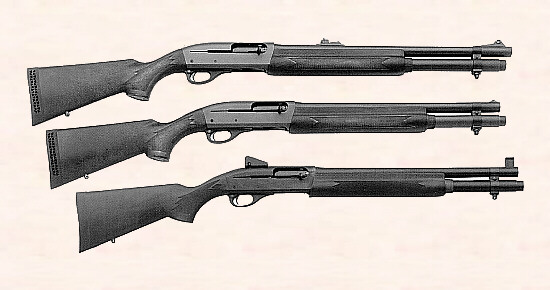



I should start by stating, for the record, that I prefer pump action shotguns over autoloaders. And, I have a few good reasons for this.
Taken altogether auto loaders are; expensive, ammunition sensitive, less versatile, more complicated, and more prone to malfunction than pump guns. Their only selling point is that they're faster than pump guns. But again, not by much.
There is one design worth considering, though, that gives you the best of both worlds. That design is the Benelli M-3. This is a combination pump/autoloader which allows you, with a simple "flick of a switch", to use the gun as a rapid fire auto loader, or a pump capable of firing specialty ammunition. And, it manages to do this without unnecessary bulk, unlike previous designs such as the Franchi SPAS-12. The only downside is cost. These, like all Benelli shotguns, are expensive. But they're well worth it.

The bead sight is absolutely the worst sight choice for a combat shotgun. Bead sights are fast and adequate for general torso area shot placement at very short ranges. But, due to their spherical shape and the lack of a rear sight for reference, precise shot placement is extremely difficult at extended ranges. The only reason they've continued to be used is due to the misconception that the combat shotgun is a close range only weapon.
The deer sight is a bit of an improvement. But, the design is seriously flawed. With the deer sight you have an open notch rear sight that is generally very small. Even worse is it's placement well forward on the barrel. This results in a sight radius scarcely longer than that of a six inch revolver. This sight makes longer shots possible, but difficult.
The single greatest improvement you can make towards extending the capability of the shotgun to hit with slugs at long distance is the addition of a receiver mounted ghost ring sight system. With the ghost ring you have a large aperture peep sight mounted back on the receiver where a rear sight is supposed to be. This gives a proper sight radius coupled with a design that's quickly and easily acquired at any range.
At 100+ yards center mass shots are easily accomplished with this sight. Yes, 100 yard shots can be made with a bead sight. But, only by very skilled shooters. And, even then, they aren't done very quickly. Give a ghost ring equipped shotgun to that same skilled shooter and see what happens.
Another benefit of ghost ring sights is the ability to precisely place shot patterns at close ranges. Within 3-5 yards the shot pattern on most cylinder bore guns is still very tight and seldom larger than 6 inches. At these ranges, because of the small shot pattern, the shotgun is fired like a rifle. With ghost ring sights you can precisely place that shot pattern exactly where you want it to go, to include hostage taker shots. With the bead sight, just like at the extended ranges, this again isn't easily done, nor does it tend to be as precise as with the ghost ring sights.
If, after all of this, you're still sold on the bead sight, just ask yourself; when was the last time you saw a new production tactical carbine or SMG made with a bead sight. This ancient design needs to be done away with and put in the grave with blackpowder muskets.
As for the best after market ghost ring sight to purchase for your weapon, MMC currently makes the best unit around. The rear sight rests in a solid steel base which has large protective "wings" on each side. This sight is very rugged and is built to withstand a lot of abuse. Quite a bit of thought and development went into this sight. One area in particular is in the sight adjustment screw. The slot is nice and wide and adjustments are easily made with the extractor rim of a 12ga. shotgun shell. Very convenient.
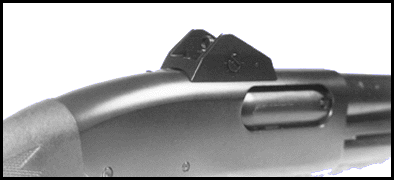
Another popular ghost ring sight is the Trac-Lock from Scattergun Technologies. This was the first mass production ghost ring sight aimed specifically at the shotgun market. It's a good sight. But, it lacks any form of protection for the sight, unlike the MMC.
When you have your ghost ring sights installed, the front sight will obviously need to be replaced. When it is, make sure you have it permanently attached by either having it pinned or soldered to the barrel. Using epoxy, no matter how advanced the formula is, won't guarantee the sight will stay on the barrel. And, Murphy's Law says that if your front sight is going to fall off it'll happen right in the middle of a gun fight. Make sure that doesn't become a possibility.
As for the best factory ghost ring sights, Benelli and Mossberg both offer good units for their guns. While not as well done as the MMC, they're good designs nonetheless. The worst, though, is the new Remington design. I have no idea why they did this, other than the "it wasn't invented here, so it must not be any good, therefore we will put our own spin on it" mentality. The rear sight is fairly decent. But, for the front sight they use a bead mounted on a square post! So, basically you still have a bead sighted gun, just with a better rear sight. The sight picture is atrocious! They really need to re-think that design.
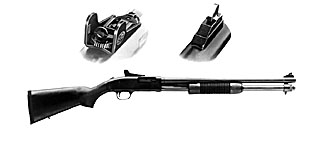

In law enforcement gunfights we have to account for every round we fire. This leads to a real problem in the general use of buckshot. While 00 buckshot is a tremendously effective manstopper, with cylinder bore shotguns it just simply can't be used for targets beyond 12 to 18 yards, depending on the gun and the shooter. Targets beyond the effective range of your buckshot require a transition to a slug in order to ensure you don't have stray pellets going past your attacker. What's needed is a barrel choking system that will tighten your pattern and extend the useful range of your shotgun with buckshot.
While we're on the subject of patterning, let me tell you this; ALL shotguns pattern differently and their patterns change depending on the load. DO NOT take this lightly. You must pattern YOUR shotgun with a given load, and stay with the load that patterns best in YOUR GUN. The old rule of thumb that states that 00 Buckshot spreads at a rate of 1 inch per yard traveled is a very general rule indeed. I can put four identical shotguns from the same production run, with consecutive serial numbers even, on the firing line at 7 yards and get patterns measuring from 4" to 10". Then I can switch loads and watch the patterns change from good to bad and vice versa. Even worse, some shotguns will produce "doughnut" patterns. In this case the shot will strike in a circular pattern leaving an absence of shot in the middle of the pattern. As the ranges increase, the likelihood of the pattern passing completely around your intended target increases. Fortunately, a simple change in load can sometimes fix this. But, you need to know, BEFORE THE GUNFIGHT, what your gun will do and how far out it will do it.
The reasons for shotgun barrels acting this way has a lot to do with the buying public's expectations of performance. Super tight buckshot patterns just haven't been an expectation with the police shotgun buying public in the past. After all, they've considered the shotgun to be a close range weapon and thus haven't placed a big demand for tight quality control on barrel production. I guarantee you those variances in sniper rifles wouldn't be tolerated. But with shotguns they are. So, they continue to churn out barrels with the thought that so long as they're fairly round and fairly straight they're good enough for government work. Well, they're not good enough and they need to be better.
Fortunately, a recent development in choke design was discovered that re-wrote the performance envelope for tactical shotguns. It was developed by Hans Vang and is called the Vang Comp Choke System. The Vang Comp Choke System is an internal modification of the shotgun barrel in which the forcing cone is relieved and the barrel is back bored so that it's the same diameter from the chamber up to a point several inches from the muzzle. At that point the barrel tapers inward thus choking the shot while retaining the original cylinder bore diameter. With this system you can still safely shoot slugs, unlike other choke systems. It's also a permanent system which adds no length to the gun and has no screw in devices to fly off and end up down range.
As for performance, I can honestly say it's phenomenal. I've seen guns with this modification go as far out as 35 yards and still keep all 9 pellets of a 00 buckshot load in the torso of a man-sized target. And, at standard confrontation ranges of 5-7 yards this choke system makes buckshot patterns so tight I would have no problem using it for hostage rescue work, with ghost ring sights of course. It's amazing! Right now it's the only choke system I can endorse and I endorse it fully.
The Vang Comp choke can be applied to any tactical shotgun barrel rather inexpensively, except for the Benelli's and others with chrome lined barrels. Those guns must be de-chromed before the machine work can be done, which costs a bit more. Otherwise, the modification is affordable and the turn around time is generally quick.
As for factory tactical shotgun choking systems, Mossberg is the only manufacturer, I know of, that offers a tactical shotgun with an internal choke system. I haven't tested one yet, but I've heard it's very good. Everyone else seems content to stay with poorly made cylinder bore barrels.
Factory magazine capacities for shotguns range anywhere from a low of 4 to a high of 8. In many cases magazine capacity can be easily increased with the addition of an extended magazine kit. Whether this is a worthy modification, or not, is up for debate. I get by just fine with a four shot magazine tube on my entry gun. Extending it, though, is out of the question since my barrel is only 13" long. But, had I gone with a 14" barrel I could have added a one shot extender that would have been flush with the end of the muzzle. But, following the doctrine of "load one, shoot one or load what you shoot", it's surprisingly easy for me to keep my shotgun topped off and fully loaded throughout just about any course of fire. So I'm not real concerned.
Of the extended magazine kits out there, the best are the Tac-Star, Choate, and Remington factory kits. The nod for the best made would have to go to Tac-Star. It's solid steel and built for punishment. The Choate and Remington designs are similar and well made, they're just not as stout as the Tac-Star.
Related to magazines are two issues you need to be aware of. First, if your gun has one of those flimsy plastic followers, replace it with a good solid one. I've seen the Remington followers break and they will jam up the gun quite badly. So, it behooves you to head Mr. Murphy off at the pass and eliminate this possibility. Second is magazine spring set. This is especially critical with the extended magazine kit springs. The rule is; the longer the spring the greater likelihood of spring set. So, as a practice, keep your shotguns downloaded by at least one round with the four shot mags and two with the extended mags. This will lessen the possibility of spring set somewhat. I also recommend annual replacement of magazine springs for all shotguns. At approx. $5.00 a spring, it's cheap insurance.
One other benefit of downloading your mags, especially if you live in a warm climate, is to eliminate what we in central California call "shell slag". This is what happens when you load a black shotgun to full capacity with plastic shells, that are packed with styrofoam buffer material, then place the gun on the dash board of a car in the summertime. All you need to do then is leave the gun in this condition with the windows rolled up for awhile and let the inside temperature of the car reach about 150+ degrees. What sometimes happens is the shells heat to the point of becoming pliable, then the spring pressure bears down on the softened shells causing them to expand within the magazine. Should you need the shotgun in a hurry, life gets real complicated, real fast. Your shotgun, unfortunately, has now become a playdough fun factory and the shells tend to be a bit sluggish on the feed, if they feed at all. Not good. But you can diminish this effect by downloading to reduce spring pressure. I'd rather have three that work in the tube than four that won't.
Carrying spare ammunition on the shotgun is a good idea and there are several ways to do it. The most common way is through the use of an elastic buttstock shell carrier. These are a very inexpensive way to pack 6 spare rounds on the buttstock. Using this method, though, interferes with your ability to shoot from the offside and shells will sometimes fall out of the holder. But, in all, it's not a bad system for the price.
A more advanced version of this is the Speedfeed stock. This is a replacement stock which holds two shells internally on each side of the stock in spring loaded tubes. It's a lot more expensive than an elastic buttstock shell carrier. But, you can shoot the gun from either side. The downside is that it's a very slow system and it too will drop shells out. This happens when a tube only has one round in it. Under recoil the round will move back against the spring just enough to move past the shell stop and gravity does the rest.
The worst set up is the sling which holds 20-25 shells. Next time you get a chance, pick up a box of 25 shells. Now, imagine that box swinging beneath your gun like a pendulum. It definitely tends to spoil your aim. Stay away from these.
The best means of carrying spare ammunition on the shotgun is the Tac-Star Sidesaddle. This unit attaches to the left side of your gun and holds 6 rounds in a perfect position to extract them, move about two inches and feed them into the gun. This is the neatest piece of gear I've ever seen and I'm so impressed with it that I have one on all of my shotguns and I'll have one on every shotgun I ever own.
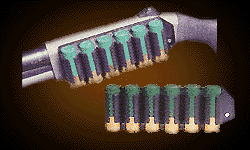
A couple notes of caution on this unit, though. They secure to the weapon by means of replacing the receiver pin(s) with screws that go through the receiver pin holes and secure the shell carrier from the other side. Some shooters have put these on and overtightened the screws to the point that they have pinched the receivers. This will void your warranty right away not to mention you may damage the gun to the point of needing repair. When you put these on, turn the screws down to the point where you feel them snug up. Then give the screw just a slight 1/16 turn to snug it further and leave it alone. I do this and I've never had the screws back out.
Secondly, the shell holder attaches to the mount plate by means of six little allen head screws. When you get your Sidesaddle, or if you have one already, take all six of the screws out and put some loc-tite on the threads. If you don't, they'll eventually back out during extended firing sessions and they're so small you'll ruin your eyesight trying to find them on the ground.
As with any tactical/defensive weapon, a light mount is a must. A tactical team gun, in particular, without a light mount is like a car without headlights. You can still get around but you're not going to be very effective or safe once it gets dark.
For most weapons, you can get by with a handheld flashlight, but shotguns, especially pumps, are extremely difficult to shoot with a handheld light. Fortunately, Sure Fire makes a dedicated replacement fore end light mount/housing for all of the popular shotguns. If they don't make one for your gun they make great universal mounts that will fit just about any shotgun.
If you're not already familiar with Sure Fire products, take my word for it, they make great gear. I have a Sure Fire light unit on my entry gun that's been subjected to an amzing amount of abuse without any problems. Currently the light housing I'm most fond of is a new design which incorporates a steady on/off switch on the left side of the unit in addition to the momentary switch on the right side. This is a good option to have.
All tactical long guns must have slings. That is a serious rule. A long gun without a sling is like a handgun without a holster. When your weapon stops working, whether it be a malfunction or you've simply run out of ammo, your first response should always be to get rid of that weapon and immediately transition to your backup sidearm. You don't have time to fool around trying to reload or clear a malfunction when people are trying to kill you, or your active coverage of an area of responsibility is critical to the safety of a fellow team member. A tactical sling on a weapon allows you to simply "let it hang" while you go for your back up.
The biggest complaint about shotguns is their recoil. And, yes, they do recoil quite a bit. But, this recoil can be managed to a surprising degree through proper training in recoil management. However, no amount of training will help if the buttstock isn't properly configured to the shooter. You don't hear it discussed much, but for a large majority of shooters a simple adjustment to the length of pull on the shotgun will drastically reduce felt recoil and improve their ability to better handle the weapon.
Currently, nearly all shotgun manufacturers produce shotguns with buttstocks designed to fit the typical six foot tall North American man. But, not everyone fits that profile. And if you don't in order to mount the weapon and acquire the sights the buttstock must be moved out of the proper shoulder pocket and usually comes to rest right on top of the radial nerve. This is a very bad place for any buttstock to be, but especially bad for one of the heaviest recoiling weapons to be. When the weapon is fired the shooter experiences PAIN. Shooters who've had this happen to them tend to shy away from the shotgun from that point on.
However, simply having the buttstock shortened will eliminate this problem and allow you to place the buttstock of the shotgun into the proper shoulder pocket. And you'll find afterwards that the recoil really isn't that bad. You'll also discover that it's much easier to manipulate the weapon, thus making you much faster on the gun. This is truly a worthy modification to consider.
It's also a fantastic idea to have a nice, thick, well design recoil pad attached to the buttstock. This will definitely dampen the felt recoil to a manageable level. One very worthy modification to this area is to round off the heel (top) of the buttpad. Having this rounded will keep the buttpad from snagging your clothing when mounting the gun to your shoulder.
As for buttstock designs you have a choice of traditional full stocks, pistol grip full stocks, (Such as the Choate after market, and the Benelli), folding stocks, and pistol grip only. For most shooters the factory traditional stocks will do just fine and are easy to modify length of pull on. Of the pistol grip full stocks, I very much like the Choate model, but because they're hollow, adjusting the length of pull isn't easily done. The Benelli version is just as difficult to adjust and, unfortunately, they apparently designed these to fit Vikings because I have yet to find an average shooter that these fit. Fitting can be done, but your gunsmith will curse you and charge you commensurably. As for the folding stocks, I don't recommend these unless you have an extreme storage problem. They do nothing to make the weapon more compact in actual use, since you'll be unfolding the stock to fire the weapon. What they WILL do is increase felt recoil, especially the factory Remington top folder. They'll also get wobbly and wiggly as they begin to wear out, which won't contribute much to accuracy. As for pistol grips only, I can't think of one good reason for these. Shooting from the hip with a full stocked gun is iffy, but at least the buttstock gives you some reference point. But, with the pistol grip you have no reference point at all. But, you will have a nicely bent wrist to absorb all of the recoil, which won't feel good at all. The only way to fire these beasts is to bring them up to eye level and shoot them like a big pistol. This is slow, inaccurate, and painful for the shooter. Stay away from these altogether.

Hopefully you now have a better understanding of the shotgun as a tactical weapon along with greater knowledge of what the shotgun is capable of doing once properly modified. No other weapon benefits more dynamically from modification than the tactical shotgun. Fortunately, the cost involved isn't that great. If you shopped wisely you could have a state of the art tactical shotgun built for less than $750.00. And, in the end you'll have the most powerful and effective close range shoulder fired weapon currently made. Not bad!
